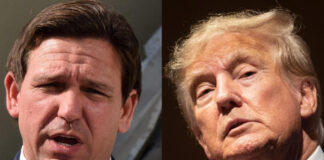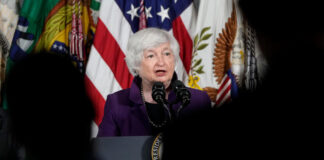APRIL 1, 2019
 Jaden Rams at a Trump event in Grand Junction, Colo., in October 2016. – Damon Winter/NY Times
Jaden Rams at a Trump event in Grand Junction, Colo., in October 2016. – Damon Winter/NY Times
Jaden Rams used to be on fire for Donald Trump. Shortly before the 2016 presidential election, when he was 13, he put on a red MAGA hat and matching tie and yelled his support at a rally in his hometown, Grand Junction, Colo.
 Mr. Rams, 16, at his school in March 2019: “I care about politics so much because it actually matters a lot of the time.” – Rachel Woolf/NY Times
Mr. Rams, 16, at his school in March 2019: “I care about politics so much because it actually matters a lot of the time.” – Rachel Woolf/NY Times
“I was getting politically charged around that time,” he said. “I was pretty passionate about a lot of the causes he was advocating for.”
Today he calls the presidential campaign and its aftermath “a travesty for American unity.” He believes much of what President Trump has done has been for the worse. Two years closer to voting age, he now leans left, and said he would register as an independent.
These are critical years for the voters of tomorrow. Political science research shows that a generation of voters is shaped for life by what happens during the teenage years and early 20s: whether the country is at war, how the economy is doing, whether the president is popular. Evidence in the Trump era so far shows young people coming of age now are tilting left.
 Alemitu, center, and Selame Caldart, right, marching for gun control in Janesville, Wis., in March 2018. – Lauren Justice/NY Times
Alemitu, center, and Selame Caldart, right, marching for gun control in Janesville, Wis., in March 2018. – Lauren Justice/NY Times
Election data suggests that the youngest voters are supporting Democrats, and surveys of teenagers not yet old enough to vote reveal them to be anxious about the current state of the country and likely to embrace liberal views.
Over all, 59 percent of people 18 to 24 say they’re Democrats, compared with 33 percent who say they’re Republicans, according to an Upshot analysis of Pew Research Center data over the last year. Even young people who self-identify as Republicans, another Pew survey found, say they hold more liberal views than older Republicans on a wide range of issues — including race relations, the causes of climate change and the involvement of government in people’s lives. The youngest Republican voters who supported Mitt Romney in 2012 were the most likely to abandon Mr. Trump in 2016.
 The Caldart sisters, 16 and 14, at school in Milwaukee: “We marched 50 miles for something that we were passionate about,” Selame Caldart said. “It’s something I’ll never forget.” – Lauren Justice/NY Times
The Caldart sisters, 16 and 14, at school in Milwaukee: “We marched 50 miles for something that we were passionate about,” Selame Caldart said. “It’s something I’ll never forget.” – Lauren Justice/NY Times
The youngest white voters are more evenly split between parties. About half of whites ages 18 to 24 say they’re Republicans. They favored Mr. Trump in the presidential election, but those who turned out in the midterm elections very narrowly backed Democrats, according to preliminary data from Catalist, a Democratic data firm. And only 39 percent of 18-to-24-year-old whites approve of President Trump, the Pew data shows.
 Chancellor, left, and Walker Haber at a Trump event in Sioux City, Iowa, in November 2016. – Damon Winter/NY Times
Chancellor, left, and Walker Haber at a Trump event in Sioux City, Iowa, in November 2016. – Damon Winter/NY Times
Also, this next generation (those born after the mid-1990s, the so-called Generation Z) will be the first in which nearly half of the electorate is nonwhite — a group that overwhelmingly votes Democratic.
“Republicans are in trouble,” said Kristen Soltis Anderson, a Republican pollster who has written a book on millennial voters. Election results show millennials holding onto their Democratic views as they age, she said. “It would not surprise me if the problem is worse, not better, with Gen Z, given the moment we’re in.”
As these young people age, it could take years before their influence is felt in the electorate, political scientists say, given that older voters turn out at much higher rates. And young Americans who connect to Mr. Trump could retain lasting ties to his party. It’s also possible that this generation will be exposed to very different influences — like an unpopular Democratic president, or an economic downturn — in just a few years.
To find out what kinds of voters they are or might become, we interviewed young people who had been on the front lines of politics over the last three years, at campaign rallies and political protests. Some, like Mr. Rams, have shifted their beliefs; others have deepened their loyalties.
“I believe that we are very blessed to be growing up and living in a country that promotes free speech and the right to bear arms and that we have a Constitution that is for the people,” said Ricky Vincent, 15, a fire department volunteer who said he felt surrounded by others who shared those values when he attended a Trump rally in Michigan last year.
Young people are receiving conflicting signals about the health of the country. Their formative years have been marked by both economic expansion and political discord. American teenagers are more stressed than adults about issues like mass shootings and the separation and deportation of immigrants, polling shows. They are coming of age at a time of relative peace, but their president speaks often of national crisis, and Congress agrees on little.
“We’re in one of the best times in history to be alive, but this divisive politics makes it feel like the world’s ending every day,” said Walker Haber, 15, a Trump supporter from Sioux Falls, S.D., who said his views were shaped by church and a wide variety of media, “from Vox to Fox.”
 The Haber brothers, 12 and 15, in Sioux Falls, S.D.: “Policy by policy, I give Trump a B+, but whether you like it or not, he has opened up politics,” Walker Haber said. – Jenn Ackerman/NY Times
The Haber brothers, 12 and 15, in Sioux Falls, S.D.: “Policy by policy, I give Trump a B+, but whether you like it or not, he has opened up politics,” Walker Haber said. – Jenn Ackerman/NY Times
Mr. Rams’s political evolution happened on the high school debate team. “I got to be exposed to a lot of different points of view about how policy impacts people and what each side truly stands for, and that shifted me,” said Mr. Rams, now 16, who hopes to run for office someday. (His father, Ronald Rams, still a Trump supporter, said he and his son agree on a lot: “Jaden’s his own man. He’s smart enough to make his own decisions and I’m not going to force him to do anything because he’d probably do the opposite anyway.”)
 Belle Shefrin at a Hillary Clinton event in Akron, Ohio, in October 2016. Todd Heisler/NY Times
Belle Shefrin at a Hillary Clinton event in Akron, Ohio, in October 2016. Todd Heisler/NY Times
Others spoke about adults in their communities furloughed by the government shutdown, or their fears that politicians weren’t responding to school shootings. Some said they believed the president did not have their interests in mind.
“I look at him, and it makes me sad that this is the leader that America has chosen to run this country,” said Alemitu Caldart, a 16-year-old from Shorewood, Wis., who said she had followed her mother’s example in activism. “I don’t think he’s a voice for all people.”
 Ms. Shefrin, 11, outside Cleveland: “I believe very much in equal rights and I believe everyone deserves to be able to vote and to have jobs and to have all the same opportunities.” – Maddie McGarvey/NY Times
Ms. Shefrin, 11, outside Cleveland: “I believe very much in equal rights and I believe everyone deserves to be able to vote and to have jobs and to have all the same opportunities.” – Maddie McGarvey/NY Times
Conventional wisdom suggests that people hold more liberal views when they’re young and age into conservatism. But history doesn’t back that up. The generation that came of age during the New Deal remained reliably Democratic as it aged; the generation that grew up with the Reagan Revolution has consistently tilted Republican.
There has been quite a bit of vote switching in recent years, with white voters holding a college degree moving to the Democrats, and those without to the G.O.P. But Andrew Gelman, a professor of statistics and political science at Columbia, and Yair Ghitza, the chief scientist at Catalist, have found that impressions about events from ages 14 to 24 are about three times as powerful in shaping political beliefs as events that happen when people are 40.
That history suggests that President Trump’s low approval rating does not bode well for the Republican Party with young people who’ve been exposed to little else, Mr. Gelman said. But he cautioned that the Democratic brand isn’t particularly popular today either.
The pattern he and Mr. Ghitza detected is also clearest for white voters. African-Americans have voted overwhelmingly for the Democratic Party regardless of their generation. Latinos and Asian-Americans are more likely to grow up with immigrant parents raised outside the American party system. But young Asian-Americans and Latinos are already tilting left, and future generations will probably show the same imprints from their formative years, said Janelle Wong, a professor of American studies at the University of Maryland.
 Ricky Vincent, right, at a Trump rally in April 2018 in Washington Township, Mich. – Jake May/The Flint Journal-MLive.com, via AP
Ricky Vincent, right, at a Trump rally in April 2018 in Washington Township, Mich. – Jake May/The Flint Journal-MLive.com, via AP
People learn politics from their parents, but they are also shaped by external events.
Caiden Fratangelo, 26, grew up in a Republican, blue-collar, union family in Pittsburgh that debated politics at the dinner table. He first registered to vote as a Republican. But he changed parties around the time he came out as transgender and got into LGBTQ rights activism.
“Being queer and moving away from Pittsburgh for several years and meeting people from different walks of life, your life experiences definitely shape your views on politics,” said Mr. Fratangelo, who was a field director for Hillary Clinton’s campaign and now works in constituent relations for a state senator.
 At the Fire Department in Clio, Mich., where Mr. Vincent, 15, volunteers: “I believe that if you work hard, you’ll succeed, and if you don’t want to put the work in, you won’t.” – Brittany Greeson/NY Times
At the Fire Department in Clio, Mich., where Mr. Vincent, 15, volunteers: “I believe that if you work hard, you’ll succeed, and if you don’t want to put the work in, you won’t.” – Brittany Greeson/NY Times
Young people are not likely to forget the activism they’re learning now, said Ella Robinson, a 16-year-old in Silver Spring, Md. The Trump era has taught her and her fellow students political savvy, she said, as their spontaneous school walkouts have been replaced by organized protests, with permits and tailored messages around issues like gun control and climate change.
“People in my generation are very aware that walkouts can only go so far,” Ms. Robinson said. “Voting needs to happen.”










































































































